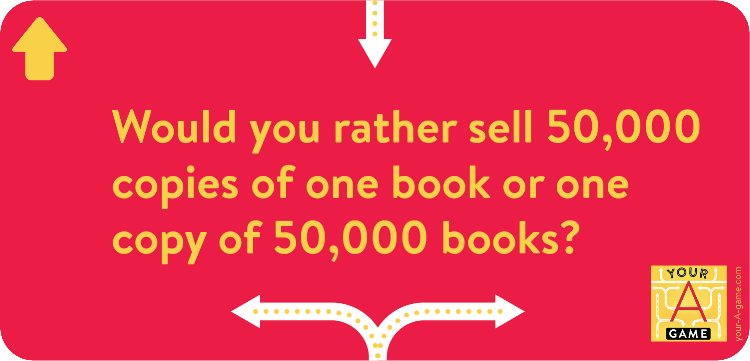Twentieth-century commerce generally used a push model. Advertisers promised all kinds of benefits without shame or logic. Job-hunters submitted resumes to land employment. Corporate raiders and banks invaded and colonized markets in a parody of imperialist empires. Businesses tried to predict success, manufacturing the mass-market, cranked-out, standardized products, and pushed them to everyone with homogeneous promo and vendors. Standardization and bulk meant customers needed to be convinced to buy things they didn’t completely want with money they didn’t have.
Push economies presuppose scarcity and uniformity. The more markets shift from scarcity and uniformity, the less you can push sales. Push publishing is brick-and-mortar friendly and bestseller dependent.
Pull economies presuppose abundance and reciprocity. The more markets fracture and specify, the more improvisatory and tailored promotion must be to gain attention. Pull publishing is pro-niche and e-commerce friendly.
The only way push marketing works is by cranking the volume by spending more time, money, and energy to boost a signal people are trying to tune out. It’s also not working. Kmart is closing stores. Coca-Cola profits are tanking despite millions in Super Bowl ads. Ford’s current bragging right is being the only American car company not bailed out by its government.
How about something closer to home?
Consider the difference between the former Borders and current Amazon.com. In the past, push bookstores piled a bestseller into its windows and sale tables, making the most of limited shelf space to capture the widest swath of customers regardless of taste or interest. Today, pull bookstores tailor their recommendations to individual customers and offer unlimited, niche-friendly inventory from limitless virtual stock.
Push marketing spends to make us spend. Pull marketing engages to make us engage. Both have their strengths and uses, but only pull marketing makes the best use of an author’s resources.

In the twenty-first century, savvy consumers, crowded stores, and nonstop promo have turned push marketing into a big, boring pill. Now, successful businesses generate a pull economy. Folks line up for the newest iPhone and then post video reviews to share personal experience. Employers recruit staff based on research and word of mouth. Today, savvy businesses have replaced centralized manufacturers with virtual commutes, outsourcing production and importing talent. Dynamic feedback improves product-market fit. Pull products feature novelty, customization, responsiveness, and services so customers can buy products specific to their needs.
Think about the companies and products that blare advertisements at you in a relentless stream: on social networks, on television, on junk mail and flyers, on billboards and buses (e.g. Coca-Cola, Kmart, Ford). That is classic, old-school nineteeth-century push marketing at its most aggressive and impersonal. Works great as a public announcement, but in a shouting mob of competing products, it only adds to the cacophony. No one rushes around to find a Coke or gabs about it breathlessly.
Now consider the latest cool gadget, film, service, cosmetic, or tool that your friends went bananas over (TiVo, Netflix, iPhone). Those items hook customer attention and reel their market in irresistibly and inexorably playing on curiosity, appetite, and emotions. That’s some cutting-edge pull marketing tugging at the monkey mind. Just lay out shiny, seductive bait and wait for the right customers to come looking. Sure enough, we hunt those products and services down and crow to our tribes about them like victorious Neanderthals. If those coveted trophies turn out to be flimflammy or disappointing, we savage them in conversations and online reviews. If they dazzle us, we praise them to the skies until they sell themselves.
Push marketing is expensive and labor intensive, but having a chat is anything but. Pull your market to you by exceeding their expectations. Best of all, word of mouth is free; all you have to do is be remarkable. Give them something to talk about. That means that the single deciding factor in the success of a book is the book.
© 2016 Damon Suede & Heidi Cullinan, All Rights Reserved

